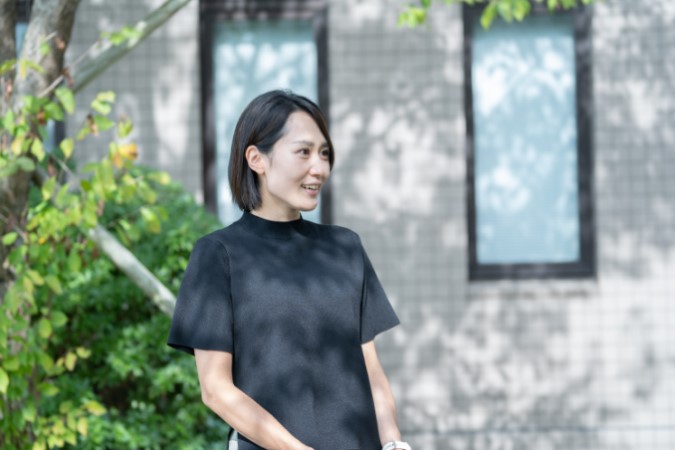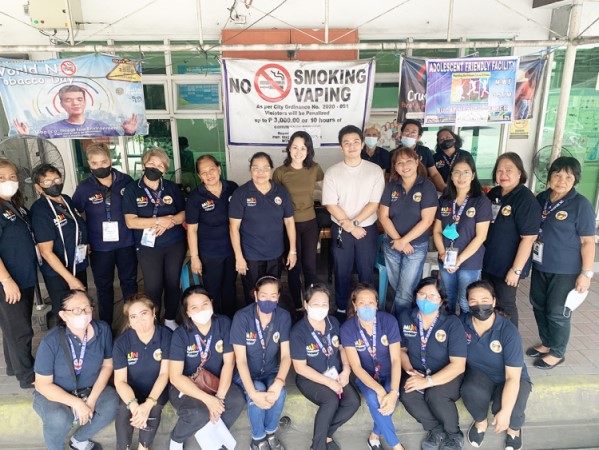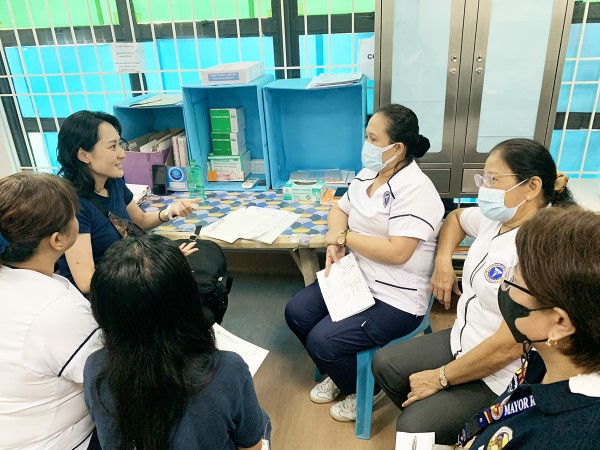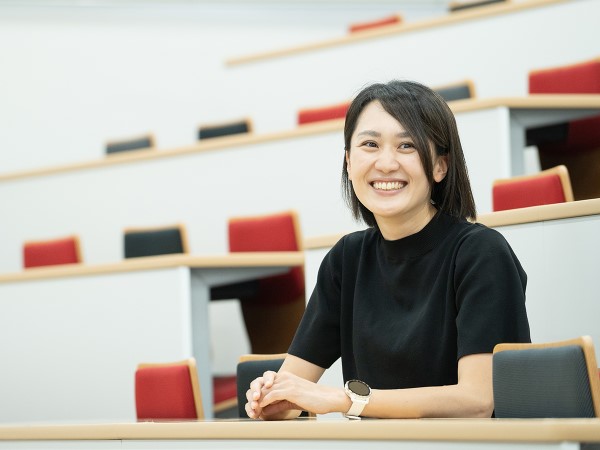The leading causes of deaths worldwide are diseases that are not acquired through infection from other people but through a combination of individual physiology and lifestyle, the so-called “noncommunicable diseases” (NCDs). Diabetes, most cancers and most heart diseases are examples, and they disproportionally affect low- and middle-income countries, where they are on a dramatic rise because of unhealthy lifestyles and insufficient health care. A health expert specializing on NCDs, Kobe University Associate Professor YAMAGUCHI Yuko compares issues and solutions across Asia such as in Japan, Taiwan, and the Philippines. We ask her what they can learn from each other and what impacts COVID-19 and Artificial intelligence (AI) have on her work.

Associate Professor YAMAGUCHI Yuko studies the interplay of noncummunicable diseases (NCDs), lifestyle and community support. She is interested in how cultural differences between Asian countries can contribute to finding solutions to the #1 cause of death worldwide. © Kobe University
Noncommunicable diseases (NCDs) are the leading cause of deaths. What are the benefits of comparing the situations in Japan, Taiwan and the Philippines?
I am interested in noncommunicable diseases (NCDs) in Asia, because these diseases are spreading especially rapidly there. One reason for that is physiology. For example, compared to Africans, Europeans and Americans, the insulin secretion capacity is lower in Asians and they also have a lower body-mass index so that they simply get diabetes more easily. And the second part to the answer is that NCDs are influenced by lifestyle and culture, and so I want to know the cultural situation in developed and developing countries in Asia, which might be more comparable to each other.
Kobe University has a Memorandum of Understanding with Taipei Medical University, which made it easy to connect, too. But with the Philippines, the university had only established connections with health centers, not with researchers. So, I tried to find papers relating to my research from Filipino researchers and approached them, and that worked well.
Social life as key to individual health

Yamaguchi works with Filipino community health volunteers to clarify their role and obstacles in promoting NCD-avoiding behaviors in the community. © Muntinlupa Health Center / Anastacia ARCIAGA
In your work, you emphasize the importance of support from the community for the prevention of NCDs. What have you learned from studying the situation in these countries and regions, compared to Japan?
Generally, to prevent NCDs, an individual approach is important. This means that health professionals instruct patients to check and manage themselves wherever possible. But this is very difficult in Japan because especially older people are affected by social isolation and have little access to preventive activities or insufficient information about them. In my previous studies, we could show a relationship between social isolation, that is, loneliness and living alone, and difficulties in implementing NCD-preventing behaviors in Japan.
Therefore, it is important to promote community-based care systems. In particular, the Japanese government is trying to promote a transition from hospital-based care to home-based care in a program called “community-based integrated care system”. They want people to live in their community as long as possible, not in the hospital. We also know through studies that elderly people are often willing to connect, they just lack the chances or have inadequate information.
In the Philippines, however, community life is quite well established and they usually have strong relationships within the community through what we call commons, shared activities and spaces. Therefore, by learning from the way community life is organized in the Philippines, it should be possible to promote effective community-based care systems in Japan, too.
On the other hand, Japan is a “super-aging” society, but other countries and regions will follow in the near future. For example, Taiwan is getting older, their population structure is similar to Japan, and they are trying to follow the Japanese example of the community-based integrated care system. And so I think the findings relating to NCD prevention can apply to these other places, too.

Yamaguchi's own experience as a hospital nurse is her motivation to develop NCD-preventing programs instead of simply administering drugs to alleviate the symptoms. © Muntinlupa Health Center / Anastacia ARCIAGA
Your work relates to SDG targets 3.4 (reduce mortality from NDC through prevention, treatment, and promotion of mental health and well-being), 3.8 (achieve universal health coverage) and 3.c/d (develop health workforce in developing countries / reduce health risks). How do you develop your work focus?
I align my research with the SDG 3. While I am not a member of any UN working group, my research projects try to follow the WHO recommendations. As in the Philippines, middle income countries have a high burden of undiagnosed, poorly controlled NCDs. That's why the WHO recommends NCD prevention especially for low-income countries. Based on the WHO recommendations, the Filipino government created the PhiliPEN, a universal health coverage project with NCD screening tests and consultations. But they still face many challenges to prevent NCDs because of limited resources. In particular, limited human resources are one of the biggest issues for NCD prevention. That's why in my research project I focus on the role of community health workers in the adoption of NCD-preventing behaviors.
I used to work as a nurse in a hospital, in the cancer ward, so I took care of many terminally ill patients. I found this work very rewarding, but I felt a dilemma because they take medicine and medical treatments but sometimes without much effect. That's why I started to get interested in public health prevention rather than treatment and medication and started to study public health in my master's and PhD courses. And because I want to connect research and implementation and focus on current global issues, especially in Asian countries, I focused on the NCDs issue.
COVID affects elderly people and those with underlying illnesses more. What kind of effect could you find in your work?
In the Philippines, the economic burden and limited human resources were the big challenges during the pandemic. For example, in the NCDs project in the Philippines, the government has an ongoing free medicine program and has provided diabetes and hypertension medicine to citizens. But during the pandemic, they couldn't get enough medicine. That's one of the issues. Also, because of limited human resources, even before the pandemic, the Philippines had too few health care providers, and during the pandemic they had to focus on COVID 19 and nobody controlled NCDs.
For developed countries and regions, like Japan or Taiwan, social isolation is the major issue during COVID 19 for the elderly. In these places, NCDs could be controlled even during the COVID19 period. But it was difficult to approach community-based prevention during that time. People lost the chance to join community activities to prevent NCDs.
We could actually measure an increase of NCDs during that time, both in Japan and in the Philippines. In the Philippines, patients with NCDs got worse. In Japan, high-risk people couldn't be identified in time.
What robots can and cannot do
Do robots have potential to help in NCD prevention?
AI and robots can support universal health coverage. Universal health coverage consists of three aspects: accessibility (for example, access to health care facilities), affordability, and availability.
In places like the Philippines, online health consultation services etc. might alleviate universal health coverage problems, for example in respect to limited health care and lack of availability or affordability of health services. In Japan, we face differences between rural areas and urban areas, and especially older people have accessibility issues. In such instances, robots and AI might help solve such regional differences.
The challenge, however, is that older people often cannot use robots and AI well. So, we additionally have an issue of acceptability, people don't accept the available technology. In health care settings, human connections are important. If only machines take care of patients, they might face psychological issues because machines can't catch feelings and the psychological implications. I think, it's easy to use robots for operations and AI for diagnosis etc. but in nursing and care settings it still remains difficult to introduce them.

"Kobe University is strong on internationality," says Yamaguchi about why she chose to work here. She has recently become Distinguished Associate Professor at the School of Advanced Studies and Research, which allows her to “develop my network and my understanding of developments with knowledge and information from other fields.” © Kobe University
Why did you choose to work at Kobe University?
Kobe University is strong on internationality. I got a bachelor's degree from another university, but I wanted to study for my master's program here, because the university has many relationships with other countries and universities, especially many exchange programs. That's why it's easy to connect with other countries in research settings and education. For example, in my master’s program I could study in Thailand. And under the diversity program, Kobe University gave me the chance and funds to study abroad at John Hopkins for a year, mostly to study statistical analysis. I still continue my research projects there.
Recently, I became a member of the Graduate School for Advanced Studies and Research. The main purpose of this project is to help researchers to improve their research skills. This means I can focus on research rather than on teaching. Also, the members of this program are not only from my field but also from many other fields. That's why I can develop my network and my understanding of developments with knowledge and information from other fields. I only joined this program this April, but I can already see the possibilities to connect with the others when I want to ask for help in my future work.
Resume
| 2008-2012 | Kyoto University, Faculty of Medicine, Department of Human Health Science |
| 2012-2014 | Nurse at the Kyoto University Hospital |
| 2014 | International studies at Chiang Mai University (Thailand) |
| 2014-2016 | Master’s program at the Graduate School of Health Sciences, Kobe University |
| 2020 | International studies at Johns Hopkins University (USA) |
| 2016-2023 | Assistant Professor (Gerontological Nursing), Graduate School of Health Sciences, Kobe University |
| 2019-2021 | Doctoral program at the Graduate School of Health Sciences, Kobe University |
| Since 2023 | Associate Professor (Gerontological Nursing), Graduate School of Health Sciences, Kobe University, Distinguished Associate Professor, School of Advanced Studies and Research, Kobe University |







